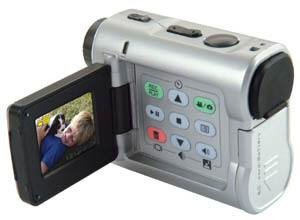 Panasonic, a leader in digital technology, is delighted to announce the launch of their second digital single-lens reflex camera (SLR) – the DMC-L10 with an interchangeable LEICA lens. The DMC-L10 features an advanced 2.5-inch free angle LCD for full time live view that offers 270 degree rotation and a versatile shooting style. A 10.1-megapixel Live MOS Sensor provides beautiful images with delicate gradation and wide dynamic range. Dust reduction with a Supersonic Wave Filter system prevents dust from attaching to the sensor to degrade the pictures. The superb image processor, Venus Engine III, boasts high quality image rendering and a high speed response.
Panasonic, a leader in digital technology, is delighted to announce the launch of their second digital single-lens reflex camera (SLR) – the DMC-L10 with an interchangeable LEICA lens. The DMC-L10 features an advanced 2.5-inch free angle LCD for full time live view that offers 270 degree rotation and a versatile shooting style. A 10.1-megapixel Live MOS Sensor provides beautiful images with delicate gradation and wide dynamic range. Dust reduction with a Supersonic Wave Filter system prevents dust from attaching to the sensor to degrade the pictures. The superb image processor, Venus Engine III, boasts high quality image rendering and a high speed response.
Four Thirds System – Developed Exclusively for digital SLR
The DMC-L10 adopts the open format of the Four Thirds system for its lens mount – so the L10 can be used with lenses made by a variety of manufacturers, giving users a host of equipment options. Drawing on leading technologies while defying any stereotype ideas in SLR cameras, Panasonic’s DMC-L10 is designed to help you make the most of your photographic creativity.
One of the DMC-L10’s real talking points is the LEICA D VARIO-ELMAR 14-50mm / F3.8-5.6 / MEGA O.I.S. lens. Sold as a complete kit – the combination of the world renowned Leica lens, with Panasonic’s excellence in digital photography – makes an impressive proposition.
Full-time Live View for a New Digital SLR Shooting Style
The full-time live view function on the LCD proposes a dramatic change in the shooting style of digital SLR cameras. The DMC-L10’s 2.5-inch large LCD offers 270 degree rotation and a versatile shooting style even in situations when looking into the viewfinder is not easy – so you don’t need to get down on bended knee, or lie flat on the ground – you can see the subject even while holding the camera up high. This free angle LCD also features an Intelligent LCD function that offers an automatic brightness level control function according to the light condition, under the strong sunlight or in darkness, to secure clear view anytime.
The full-time live view gives users more shooting flexibility and greater convenience not previously achieved by conventional digital SLR cameras without live view capability. Not one to rest on its laurels, Panasonic introduces another first for a digital SLR camera by incorporating a Face Detection and Intelligent ISO Control function. The face detection system detects human faces (up to 15 human faces can be detected simultaneously) and sets a focus and appropriate exposure to capture a face clearly and beautifully lit. The Intelligent ISO Control function detects and meters the movement of the subject and sets the suitable ISO setting and the shutter speed according to the amount of the movement to suppress the generation of motion-blur in the picture.
The live view enables the user to check the outcome image in advance after compensating the exposure or adjusting the white balance. The white balance can be adjusted in the area of two-axis of coordinates precisely. Furthermore, the DMC-L10 provides options of picture taste with a function called Film Mode. Each analog film has its characteristics, for example colour, contrast, gradation and these effect the outcome of the picture, they are ways of expression. With the DMC-L10, the Film Mode allows you to choose the one that takes the best advantage of the scene or the subject you take out of a total of nine film modes including Standard, Dynamic, Nature, Smooth, Nostalgic, Vibrant, Standard B/W, Dynamic B/W and Smooth B/W, with the capability of fine adjustment of contrast, sharpness, saturation and noise reduction. All these settings can be confirmed before you take the picture.
Users can also change the aspect ratio (4:3, 3:2 and 16:9) according to the situation. As a leader in the flat panel market, Panasonic has been proposing further enjoyment of photography, by viewing the dynamic photos you take in HD (high-definition) 1920 x 1080 resolution image size on 16:9 wide screens.
In conventional digital SLR cameras, the live image could be seen only through the view finder and the LCD existed just for the playback of images once taken. But with the DMC-L10, any trials of setting, adjustment and effect can be checked beforehand, ensuring the picture will be just as the user intended.



























